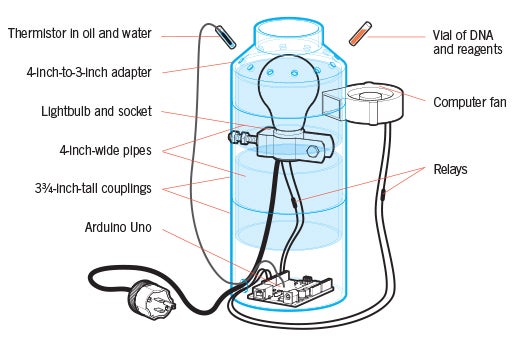Gene Machine
A pipe that copies DNA using the heat of a lightbulb.

Biology’s equivalent of an office copier is a PCR machine. PCR, short for polymerase chain reaction, is now a staple in crime-scene forensics, heredity tests, and organism hijacking. It’s a mind-boggling feat. Among billions of base pairs that make up DNA’s genetic code, PCR finds exact sequences and, in a couple of hours, makes billions of copies—enough to decode or splice together useful combinations of genes. Professional machines cost about $10,000 dollars each, but Russell Durrett has devised one from PVC pipes, a 150-watt lightbulb, a computer fan, a cheap microcontroller, and a few reagents he ordered online.
1) PILE UP
Stack five pieces of PVC piping to form a silo [right] that holds vials of DNA, heats them with a lightbulb, and cools them with a computer fan.
Top: Drill a dozen or so ¼-inch holes into the top of a slanted adapter (to hold the vials), fit a pipe inside the adapter’s base, and cut a square hole in the exposed pipe to match a computer fan’s exhaust port.
Middle: Cut the same square port in the top of a straight PVC coupling and hot-glue the fan in place. Drill a hole into the coupling’s side, just above the center, and bolt on a clamped lightbulb socket.
Bottom: Drill a hole in a second coupling for a bundle of wires leading to an Arduino Uno microcontroller.
2) WIRE UP
Connect the socket and computer fan to 5-volt relays, and link them to the Arduino. Lead one socket wire to a 110-volt AC power source, and wire a thermistor to the Arduino. Insert the thermistor into a vial containing mineral oil and water, and place it in a vial hole. This gives the Arduino temperature data, allowing it to turn the lightbulb—and heat—on and off.
3) PICK A GENE
Whether you’re testing breakfast cereal for genetically modified grains or screening yourself for HIV resistance, pick a gene to copy. You’ll need to order from the Internet reagents that can hijack DNA-copying molecules [see “How It Works,” on the next page.]
HOW IT WORKS
PCR machines cycle temperature to enable DNA-copying reagents, including primers, nucleotides, and the enzyme Taq polymerase.

201ºF
201ºF
DNA temporarily unzips into two strands.

131°F
131°F
Primers—small pieces of DNA that “prime” replication—attach to the ends of a gene.

162°F
162°F
Taq polymerase recognizes the primers, latches on, and copies DNA between them.
. . . And Repeat
In the first five minutes, PCR makes two copies of a gene. Subsequent 30-second cycles continue the doubling. By the eighth cycle, 256 genetic copies exist, and by the 30th—
a couple of hours later—there are more than a billion.
Time: 5 hours
Cost: $50
Difficulty: 3/5
For Durrett’s complete build instructions, download this PDF. Arduino code is available here.
This article originally appeared in the May 2013 issue of Popular Science. See the rest of the magazine here.